 Gastric lavage technique
Gastric lavage technique
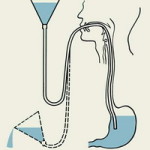
Gastric lavage is carried out both for therapeutic and diagnostic purposes. This probe procedure is based on the principle of communicating vessels and serves to pump out the contents from the stomach. The technique of gastric lavage requires concentration, knowledge of anatomy and physiology, and skills in manipulating the phantom from the nurse.
Indications for gastric lavage
- Poisoning by ingested poisons, alcohol, drugs, other toxic agents.
- Food poisoning.
- Gastric pathologies, including gastritis, with abundant mucus formation.
- Diagnosis of oncological diseases of the gastrointestinal tract.
- Identification of the pathogen in inflammatory processes in the stomach, as well as in the lungs and bronchi, when the patient cannot collect sputum.
Contraindications for gastric lavage
- Stenosis of the esophagus, pharynx.
- Stomach or esophageal bleeding.
- Burns of the esophagus and stomach.
- The presence of convulsions, convulsive readiness.
- Respiratory and heart failure in the stage of decompensation.
- Remote periods after poisoning with strong solutions of acids and alkalis (more than 6-8 hours).
- Unconscious or soporous state of the patient when intubation is impossible (at the prehospital stage).
- Acute myocardial infarction and acute disorders of cerebral circulation (strokes).
- Motor excitation and active resistance of the patient.
Equipment for gastric lavage
- Thick gastric tube (diameter 10-12 mm) 1-1.5 meters long. The probe must be sterile.
- Sterile rubber tube to extend the tube or a second gastric tube.
- Glass tube for connecting probes.
- Funnel with a capacity of 0.5 - 1.0 liters.
- Gag.
- Language holder.
- Sterile vaseline oil.
- Sterile wipes.
- A mug or ladle for pouring water into a funnel.
- A bucket of water at room temperature.
- Basin or other container for draining wash water.
- 2 oilcloth aprons, towels, gloves, mask.
- Waterproof marker.
The system for gastric lavage (probes, funnel, tube) is disassembled, but in a set it is sterilized and stored in a sealed form.
Gastric lavage technique
- We assemble the system.
- We establish a trusting relationship with the patient, explain the course of the procedure to him, and obtain consent to carry it out.
- We make sure there are no contraindications.
- We put on oilcloth aprons for ourselves and the patient. It is more convenient if the procedure is carried out by 2 people.
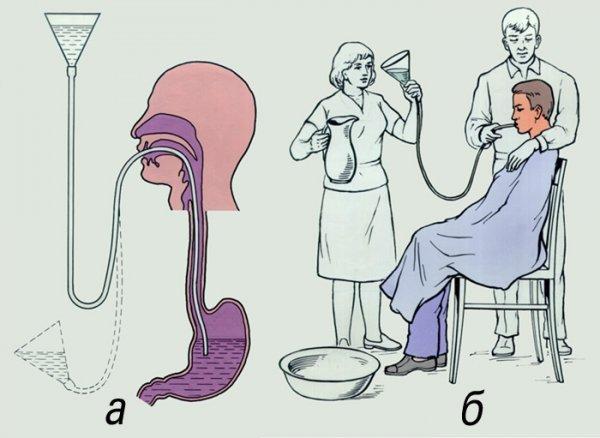
- We measure the length of the inserted part of the probe - from the patient's incisors to his navel, add the length of the palm. We make a mark on the probe with a marker.
- We seat the patient on a chair so that his back fits snugly against the back of the chair.
- If the patient has dentures, we remove them.
- Slightly tilt the patient's head forward, then put the pelvis at his feet.
- We put on gloves.
- We stand to the right of the patient and offer him to open his mouth.
- We lubricate the blind end of the probe with vaseline oil, and in its absence we moisten it with water.
- We take the probe in the right hand at a distance of 10 cm from the blind end, put it on the root of the patient's tongue.
- Carefully insert the probe through the esophagus into the stomach to the mark. At this time, the patient breathes deeply through the nose and makes swallowing movements.
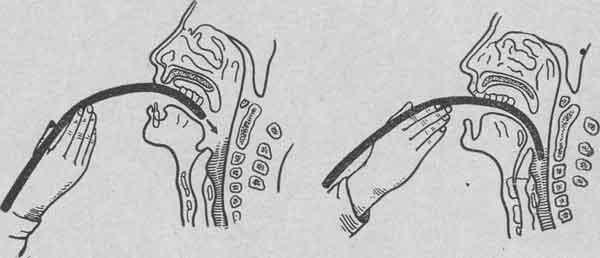
Important!
If the patient develops cough, suffocation, cyanosis, remove the probe immediately!
- We lower the funnel of the system to the level of the patient's knees, slightly tilting it so that the contents of the stomach pour out.
- Pour water into the funnel, filling it to the brim.
- Slowly raise the funnel up so that the water reaches the mouth.
- We lower the funnel below the level of the patient's knees, drain the contents spilled from the stomach into the pelvis. At the same time, we do not lower the crow with the wide part down, but slightly tilt it so that the liquid level in the funnel is in the same place as the level of gastric contents.
- We collect the first portion of washing water in a separate container for diagnostic testing in the bacteriological laboratory.
- We repeat the washing procedure several times until clean washing water is obtained.
- Carefully remove the probe from the patient's stomach through a towel.
- We disassemble the system and place it in a container with a disinfectant solution.
- We give the patient to rinse the mouth and wipe around the lips with a napkin.
- We provide the patient with physical and mental peace.
- We carry out disinfection of the collected wash water in the basin, filling them with dry bleach in a ratio of 1: 5 or another disinfectant according to the instructions.
- We disinfect used tools and all waste materials using disinfectants and withstanding exposure.

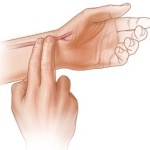
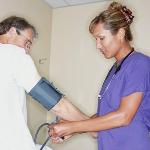
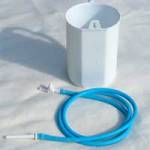
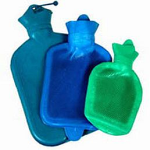
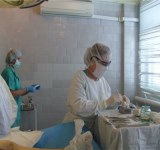
Thank you for the information. The gastric lavage technique is described in great detail. Indeed, gastric lavage often helps with poisoning.